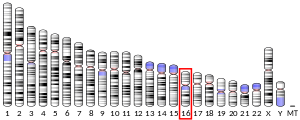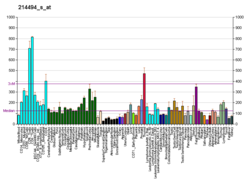Paraplegin is a protein that in humans is encoded by the SPG7 gene located on chromosome 16.[5][6][7]
| SPG7 | |||||||||||||||||||||||||||||||||||||||||||||||||||
|---|---|---|---|---|---|---|---|---|---|---|---|---|---|---|---|---|---|---|---|---|---|---|---|---|---|---|---|---|---|---|---|---|---|---|---|---|---|---|---|---|---|---|---|---|---|---|---|---|---|---|---|
| |||||||||||||||||||||||||||||||||||||||||||||||||||
| Identifiers | |||||||||||||||||||||||||||||||||||||||||||||||||||
| Aliases | SPG7, CAR, CMAR, PGN, SPG5C, paraplegin matrix AAA peptidase subunit, SPG7 matrix AAA peptidase subunit, paraplegin | ||||||||||||||||||||||||||||||||||||||||||||||||||
| External IDs | OMIM: 602783; MGI: 2385906; HomoloGene: 31133; GeneCards: SPG7; OMA:SPG7 - orthologs | ||||||||||||||||||||||||||||||||||||||||||||||||||
| |||||||||||||||||||||||||||||||||||||||||||||||||||
| |||||||||||||||||||||||||||||||||||||||||||||||||||
| |||||||||||||||||||||||||||||||||||||||||||||||||||
| |||||||||||||||||||||||||||||||||||||||||||||||||||
| |||||||||||||||||||||||||||||||||||||||||||||||||||
| Wikidata | |||||||||||||||||||||||||||||||||||||||||||||||||||
| |||||||||||||||||||||||||||||||||||||||||||||||||||
Structure
editThe SPG7 gene contains 21 exons and encodes for a protein that is approximately 88 kDa in size. Two transcript variants encoding distinct isoforms have been identified for this gene.
The structure of the SPG7 resolved by X-ray crystallography reveals that the protein functions as a hexamer and is structurally most similar to bacterial FtSH proteases. It contains an FtsH-homology protease domain as well as an AAA+ homology ATPase domain. The protein is thought to use ATPase-driven conformational changes to the AAA-domain in order to deliver the substrate peptides to be degraded to its protease core.[8]
Function
editThe SPG7 protein is a nuclear-encoded metalloprotease protein that is a member of the AAA protein family. Members of this protein family share an ATPase domain and have roles in diverse cellular processes including membrane trafficking, intracellular motility, organelle biogenesis, protein folding, and proteolysis. The SPG7 protein is a transmembrane protein that is located to the inner mitochondrial membrane, and is part of the m-AAA metalloproteinase complex, which constitutes one of the known intra-mitochondrial proteases that function in mitochondrial protein quality control.
Interactions
editSPG7 interacts with AFG like AAA ATPase 2 (AFG3L2) on the mitochondrial inner membrane to form the m-AAA metalloproteinase complex.
Clinical significance
editMutations associated with this gene cause autosomal recessive spastic paraplegia 7, a neurodegenerative disorder that is characterized by a slow, gradual, progressive weakness and spasticity of the lower limbs. SPG7 mutations have also been associated with other undiagnosed ataxia.[9][10][11]
In model animals, knockdown of spastic paraplegia 7 by siRNA inhibits the early stages of HIV-1 replication in 293T cells infected with VSV-G pseudotyped HIV-1.[12] It has been shown that an SPG7 variant escapes phosphorylation-regulated processing by AFG3L2 and increases mitochondrial reactive oxygen species generation and is correlated with many clinical phenotypes.[13] Furthermore, SPG7 deficiency is associated with abnormal mitochondrial DNA maintenance, which may lead to secondary mitochondrial DNA lesions and impaired respiratory activities and mitochondrial functions.[14]
References
edit- ^ a b c GRCh38: Ensembl release 89: ENSG00000197912 – Ensembl, May 2017
- ^ a b c GRCm38: Ensembl release 89: ENSMUSG00000000738 – Ensembl, May 2017
- ^ "Human PubMed Reference:". National Center for Biotechnology Information, U.S. National Library of Medicine.
- ^ "Mouse PubMed Reference:". National Center for Biotechnology Information, U.S. National Library of Medicine.
- ^ Casari G, De Fusco M, Ciarmatori S, Zeviani M, Mora M, Fernandez P, et al. (Jun 1998). "Spastic paraplegia and OXPHOS impairment caused by mutations in paraplegin, a nuclear-encoded mitochondrial metalloprotease". Cell. 93 (6): 973–83. doi:10.1016/S0092-8674(00)81203-9. PMID 9635427.
- ^ De Michele G, De Fusco M, Cavalcanti F, Filla A, Marconi R, Volpe G, et al. (Jul 1998). "A new locus for autosomal recessive hereditary spastic paraplegia maps to chromosome 16q24.3". American Journal of Human Genetics. 63 (1): 135–9. doi:10.1086/301930. PMC 1377251. PMID 9634528.
- ^ "Entrez Gene: SPG7 spastic paraplegia 7, paraplegin (pure and complicated autosomal recessive)".
- ^ Karlberg T, van den Berg S, Hammarström M, Sagemark J, Johansson I, Holmberg-Schiavone L, et al. (2009). "Crystal structure of the ATPase domain of the human AAA+ protein paraplegin/SPG7". PLOS ONE. 4 (10): e6975. Bibcode:2009PLoSO...4.6975K. doi:10.1371/journal.pone.0006975. PMC 2734466. PMID 19841671.
- ^ Pfeffer G, Pyle A, Griffin H, Miller J, Wilson V, Turnbull L, et al. (2015). "SPG7 mutations are a common cause of undiagnosed ataxia". Neurology. 84 (11): 1174–6. doi:10.1212/WNL.0000000000001369. PMC 4371411. PMID 25681447.
- ^ Warnecke T, Duning T, Schirmacher A, Mohammadi S, Schwindt W, Lohmann H, et al. (2010). "A novel splice site mutation in the SPG7 gene causing widespread fiber damage in homozygous and heterozygous subjects". Mov. Disord. 25 (4): 413–20. doi:10.1002/mds.22949. PMID 20108356. S2CID 8667332.
- ^ Casari G, De Fusco M, Ciarmatori S, Zeviani M, Mora M, Fernandez P, et al. (1998). "Spastic paraplegia and OXPHOS impairment caused by mutations in paraplegin, a nuclear-encoded mitochondrial metalloprotease". Cell. 93 (6): 973–83. doi:10.1016/s0092-8674(00)81203-9. PMID 9635427.
- ^ König R, Zhou Y, Elleder D, Diamond TL, Bonamy GM, Irelan JT, et al. (Oct 2008). "Global analysis of host-pathogen interactions that regulate early-stage HIV-1 replication". Cell. 135 (1): 49–60. doi:10.1016/j.cell.2008.07.032. PMC 2628946. PMID 18854154.
- ^ Almontashiri NA, Chen HH, Mailloux RJ, Tatsuta T, Teng AC, Mahmoud AB, et al. (2014). "SPG7 variant escapes phosphorylation-regulated processing by AFG3L2, elevates mitochondrial ROS, and is associated with multiple clinical phenotypes". Cell Rep. 7 (3): 834–47. doi:10.1016/j.celrep.2014.03.051. PMID 24767997.
- ^ Pfeffer G, Gorman GS, Griffin H, Kurzawa-Akanbi M, Blakely EL, Wilson I, et al. (2014). "Mutations in the SPG7 gene cause chronic progressive external ophthalmoplegia through disordered mitochondrial DNA maintenance". Brain. 137 (Pt 5): 1323–36. doi:10.1093/brain/awu060. PMC 3999722. PMID 24727571.
Further reading
edit- Pullman WE, Bodmer WF (Apr 1992). "Cloning and characterization of a gene that regulates cell adhesion". Nature. 356 (6369): 529–32. Bibcode:1992Natur.356..529P. doi:10.1038/356529a0. PMID 1560826. S2CID 9946996.
- Koyama K, Emi M, Nakamura Y (Apr 1993). "The cell adhesion regulator (CAR) gene, TaqI and insertion/deletion polymorphisms, and regional assignment to the peritelomeric region of 16q by linkage analysis". Genomics. 16 (1): 264–5. doi:10.1006/geno.1993.1173. PMID 8098008.
- Pullman WE, Bodmer WF (Feb 1993). "Cloning and characterization of a gene that regulates cell adhesion". Nature. 361 (6412): 564. doi:10.1038/361564c0. PMID 8429914.
- Durbin H, Novelli MR, Bodmer WF (Dec 1997). "Genomic and cDNA sequence analysis of the cell matrix adhesion regulator gene". Proceedings of the National Academy of Sciences of the United States of America. 94 (26): 14578–83. Bibcode:1997PNAS...9414578D. doi:10.1073/pnas.94.26.14578. PMC 25060. PMID 9405655.
- Settasatian C, Whitmore SA, Crawford J, Bilton RL, Cleton-Jansen AM, Sutherland GR, et al. (1999). "Genomic structure and expression analysis of the spastic paraplegia gene, SPG7". Human Genetics. 105 (1–2): 139–44. doi:10.1007/s004399900087. PMID 10480368.
- Kremmidiotis G, Gardner AE, Settasatian C, Savoia A, Sutherland GR, Callen DF (Aug 2001). "Molecular and functional analyses of the human and mouse genes encoding AFG3L1, a mitochondrial metalloprotease homologous to the human spastic paraplegia protein". Genomics. 76 (1–3): 58–65. doi:10.1006/geno.2001.6560. PMID 11549317.
- McDermott CJ, Roberts D, Tomkins J, Bushby KM, Shaw PJ (Jun 2003). "Spastin and paraplegin gene analysis in selected cases of motor neurone disease (MND)". Amyotrophic Lateral Sclerosis and Other Motor Neuron Disorders. 4 (2): 96–9. doi:10.1080/14660820310012718. PMID 14506940. S2CID 45890908.
- Pirozzi M, Quattrini A, Andolfi G, Dina G, Malaguti MC, Auricchio A, et al. (Jan 2006). "Intramuscular viral delivery of paraplegin rescues peripheral axonopathy in a model of hereditary spastic paraplegia". The Journal of Clinical Investigation. 116 (1): 202–8. doi:10.1172/JCI26210. PMC 1312020. PMID 16357941.
- Elleuch N, Depienne C, Benomar A, Hernandez AM, Ferrer X, Fontaine B, et al. (Mar 2006). "Mutation analysis of the paraplegin gene (SPG7) in patients with hereditary spastic paraplegia". Neurology. 66 (5): 654–9. doi:10.1212/01.wnl.0000201185.91110.15. PMID 16534102. S2CID 23463503.
- Warnecke T, Duning T, Schwan A, Lohmann H, Epplen JT, Young P (Jul 2007). "A novel form of autosomal recessive hereditary spastic paraplegia caused by a new SPG7 mutation". Neurology. 69 (4): 368–75. doi:10.1212/01.wnl.0000266667.91074.fe. PMID 17646629. S2CID 20106633.





